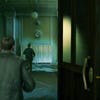Digital Foundry: Hands-on with Quantum Break
UPDATE: Remedy reveals resolution and anti-aliasing details.
UPDATE 22/3/16 9:00am: Remedy has released a statement explaining resolution and image quality on Quantum Break. It verifies our initial hypothesis on how the game produces its presentation - a 720p base resolution with temporal reconstruction - but adds new detail, such as the addition of high quality multi-sampling anti-aliasing to the mix:
"Quantum Break's 1080p output is a temporal reconstruction from four previous 720p 4x MSAA frames. This approach gets us high pixel quality in combination with complex shading and effects, allowing us to achieve a cinematic look. However, varying sample counts between passes and temporal upscaling makes talking about resolution, as it is traditionally understood, complicated in the case of Quantum Break. Since the start of Quantum Break's development, the most important thing for Remedy and Microsoft has been delivering a compelling gaming experience with superior artistic quality. This is what Remedy is renowned for. We're confident that we have achieved this, and can't wait to hear what fans think on April 5 when they play the game."
In effect, we are seeing the technique used in Alan Wake on Xbox 360 as an initial basis - a sub-native resolution paired with excellent 4x MSAA. But crucially, on top of that, visual information from four previous frames is integrated into the current one to increase perceived resolution - explaining how standard pixel counting on static scenes produces a higher result. We'll have more on this, along with a deeper look at Quantum Break's remarkable visuals in our upcoming launch coverage.
Original story: Uncharted 4 may be PlayStation 4's showstopper, but it's Quantum Break leading the charge for Xbox One. Blending cinematic third-person action with live action segments, Remedy's latest title is a coming to fruition of Microsoft's original plan to converge TV and video game content into one package. We recently sampled the first two chapters of the game at an event hosted by Remedy, and came away impressed by the technology used to bring the game to life. However, there are also noticeable compromises at work in bringing the game's rich filmic visuals to Xbox One that perhaps distract from the experience.
From the outset, the use of film grain, depth of field, and camera and object blur sets the tone for the game, creating a distinctly soft-focused look that squarely hits the cinematic target the developers are aiming for. Image quality stands out here, for both good and bad reasons. On the one hand Remedy's anti-aliasing solution in Quantum Break is excellent, creating a smooth presentation, though some shimmering is present across edges in motion. However, the game also appears soft compared to titles running natively at 1080p, or even 900p for that matter.
In fact, nailing down resolution proves rather difficult, due in part to how various elements on screen are rendered. Based on Remedy's own Siggraph 2015 white paper, we understand screen-space lighting, ambient occlusion, and global illumination pipelines are all handled at 1280x720 on Xbox One in order to budget for a 33.3ms render-time.
Curiously, the paper also states Xbox One's final output is 1920x1080, and that's where there is some confusion - as we've yet to see evidence of full HD 1080p gameplay in close analysis - barring the title's HUD elements and menus. In every scene tested so far, a native resolution of 720p is the consistent result found in each pixel count test - so while there's every possibility of individual render targets operating at higher resolutions, basic geometry that we're able to measure hands in a 720p result as things stand.
We have yet to receive an official response from Remedy on the exact set-up in use, so there may be more to this story - we'll update once a response arrives and continue to look into it more closely as we prepare our launch coverage. Bearing in mind the team's history with smart rendering techniques on older hardware, we'd expect a similar approach to its current-gen work. In Alan Wake's case we saw the game running at a native 960x544 - a big drop down from native 720p, but mitigated by the application of 4x MSAA that worked really well in combination with the game's aesthetic. The results were often breathtaking, and as a last-gen title it proved that resolution wasn't the be all and end all of image quality - a philosophy that carries over to an extent to Quantum Break.
A mixture of strong post effects (such as film grain and motion blur), plus excellent anti-aliasing work well in hiding much of the stair-stepping we'd expect of a lower resolution game. Added to this, image quality appears sharper and noticeably cleaner in more static scenes, where a pixel count suggests something closer to a 900p presentation. A temporal reconstruction anti-aliasing solution is a strong contender - a technique where information from previously rendered frames is blended with the current one.
While Quantum Break remains visually impressive - stunning in many areas, in fact - the core pixel count is clearly a factor in the presentation. However, it is not the most striking compromise we noted in Quantum Break's visual make-up. Draw distances for textures and shadows stand out, and it's commonplace to see assets switch between quality levels as you approach them, making for some rough-looking scenes at times. Additionally, some volumetric light shafts seem very blocky, rendering at what looks like 1/16th of the final 1080p output. While we appreciate the need to pare back various elements for performance reasons, sometimes the impact in visual quality can be a little too distracting.
Of course, the range of advanced effects work also helps to create many impressive visual moments throughout the opening few hours of the game we tested, and is central to creating an image that closely aligns with the TV show. The combined use of global illumination, volumetric lighting, and screen-space effects help to create a world with plenty of depth and ambience for shoot-outs and action scenes to take place. Objects and characters sit naturally in the scene, and a physically-based approach to rendering allows for surfaces to be realistically depicted under a variety of lighting conditions.
Characters are a particular high point, appearing highly lifelike and closely matching their real-life counterparts. Here, Remedy performs a complete scan and performance capture on the actors before applying the data to the in-game models, resulting in realistic skin and surface shaders, and some of the best lip-syncing we've seen in a game so far. It's impressive stuff, and the result is that the in-engine cut-scenes and live action cinematics actually complement each other very well, rather than looking out of place. That said, animation doesn't quite hit the same standards, with this aspect of the game appearing a little stiff and unnatural - particularly during gameplay when transitions between movements don't flow together as smoothly as one would expect.
Overall, there's a lot of advanced technology powering Quantum Break, but ultimately some compromises had to be made in order to get the game running smoothly on Xbox One hardware. However, on the plus side, these considerations allow for a stable level of performance throughout much of the opening few hours of the game we played. Remedy targets a 30fps update for Quantum Break, and the engine often delivers - even during some intense, effects-heavy scenes.
For example, an early firefight against heavily armed Monarch forces set inside a university restoration area sees the use of multiple lighting effects and post-processing techniques deployed across the duration of gameplay. Physics-based elements like chip damage spray debris across the ground, while the use of volumetric lighting adds a layer of mist to the air. It's dynamic, visually arresting and great fun - the gunplay mechanic is hugely improved over Remedy's last-gen efforts with Alan Wake.
To the game's credit, frame-rates remain solidly at 30fps throughout the entire sequence, and this level of stability continues as we enter the surrounding rooms and corridors. Occasionally, we're graced with a mild screen wobble - caused by adaptive v-sync tearing when traversing some areas - but these issues quickly disappear.
Moving into exterior locations, a different turn of events unfolds. More open locations combined with continued use of advanced effects work can impact performance to a certain extent. Tearing and frame-rate drops result in judder and reduced controller response here, with this having a knock-on effect to gameplay. Performance suffers just as we take aim at surrounding enemies, and the variable levels of latency and visible stutter make it harder to take accurate shots. Once the engine catches its breath and frame-rates stabilise these issues are fully resolved.
Thankfully, outside of this one particular scene, performance elsewhere in the game is noticeably more solid in the areas we tested. Outdoor shootouts set in the second act only exhibit minor tearing or dropped frames, with the experience feeling more consistent as a result. Cut-scenes hold up well too, although we do encounter the odd stutter from time to time, which is quickly resolved.
The overall impression is that Quantum Break is well-optimised around Xbox One hardware, with a mostly stable level of performance and some unique visual effects work. Similar to Alan Wake, there's the sense that Remedy has shaped its own aesthetic here, creating a distinctive title. The question remains as to whether some of the trades Remedy has made perhaps cut too deep into the overall quality of the presentation. That said, the opening few hours only offer a slice of the overall experience. Existing trailers showcase far more in the way of action-packed scenes with bigger set-pieces that push the engine much further than anything we've seen thus far. Based on this initial playtest, we can't wait to get further into the game to see just how far Remedy is able to push this technology.
But let's not forget that there's also a PC version in development too. We didn't have time to sample this at the press event, but Remedy were pretty open on the state of the build at that time. Limited to 1080p at 30fps, it still required plenty of work before launch. The developer is promising a maximum 4K experience, but it remains to be seen exactly how this will pan out, or exactly what kind of hardware will be required to make this happen [UPDATE 20/3/16 07:35am: We previously said that Remedy promised 4K at 60fps - this is an error, the developer has only confirmed 4K support and made no comment about performance at this resolution]. Confidence in the Windows App Store and the Universal Windows Platform here at Digital Foundry isn't exactly high right now, as we continue to struggle with Gears of War: Ultimate Edition on PC - fingers crossed that Remedy's PC work delivers a much more polished, optimised product.






















